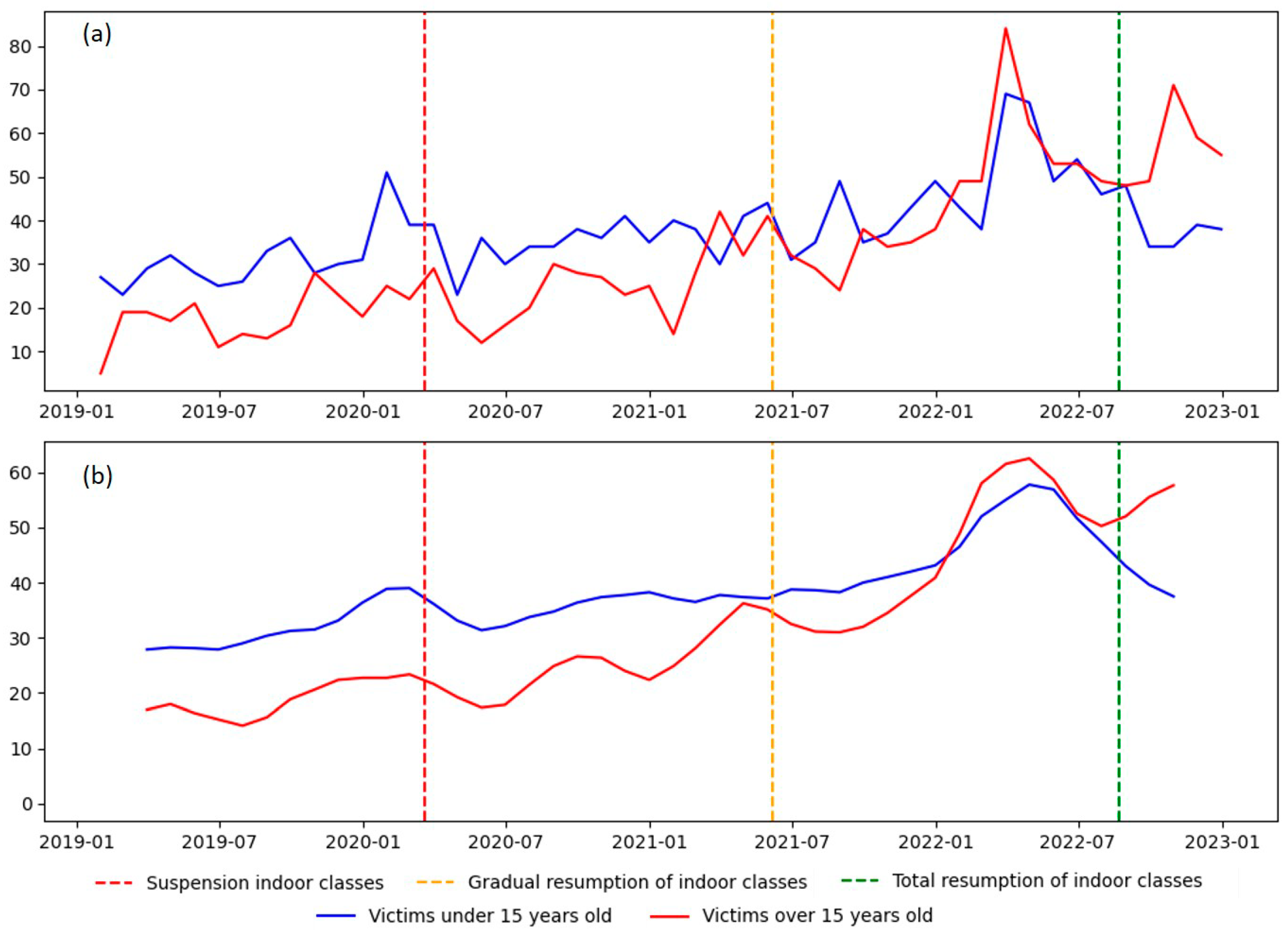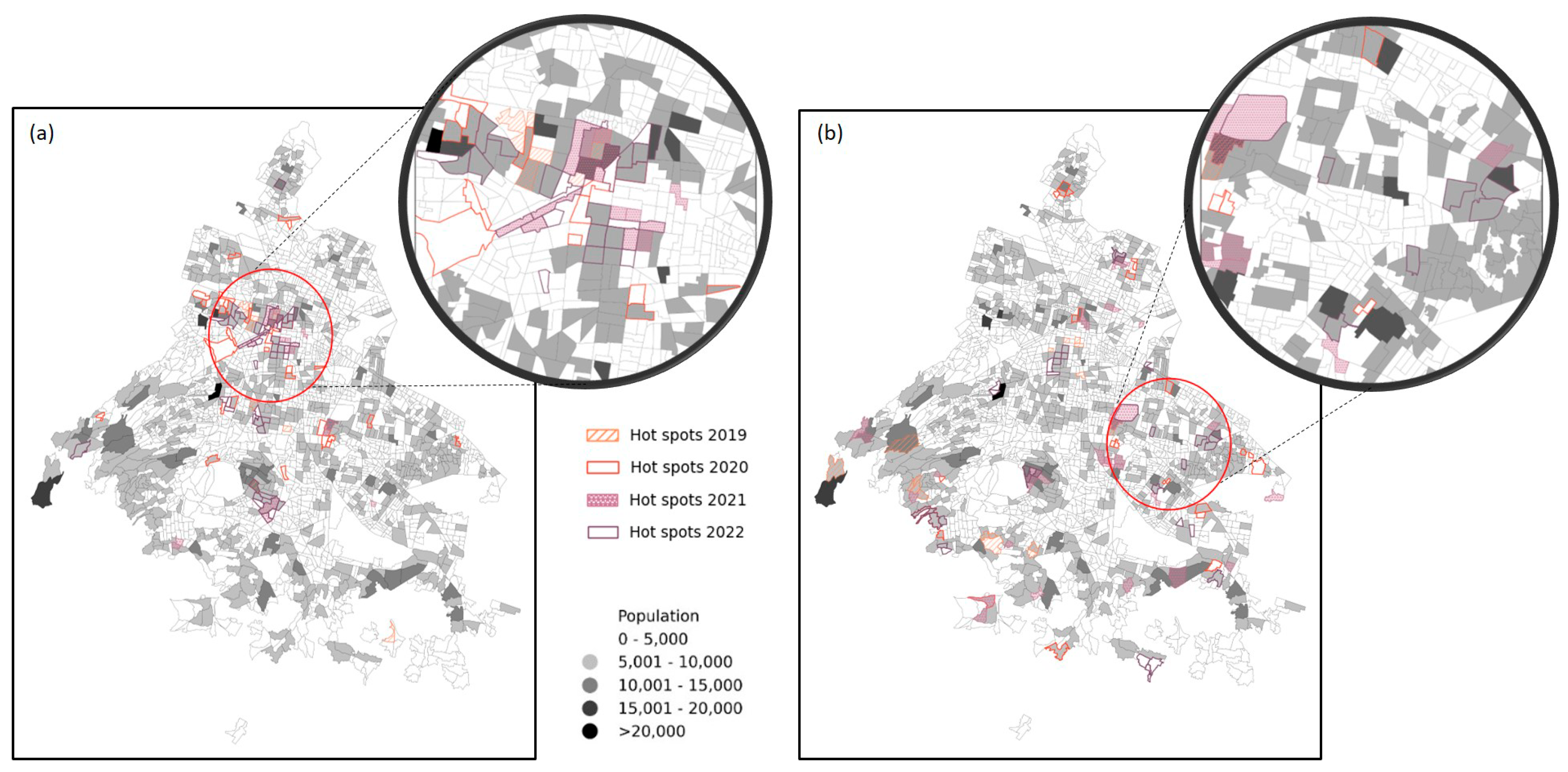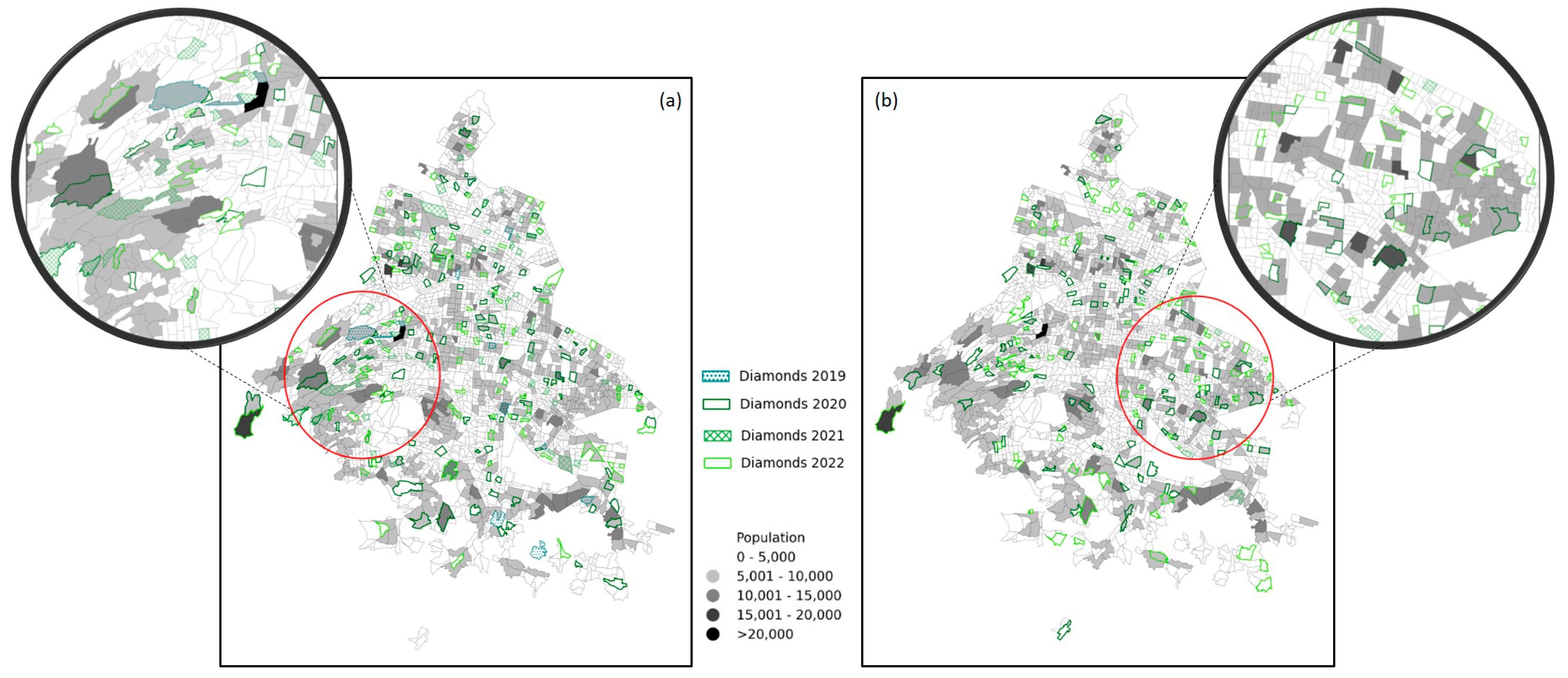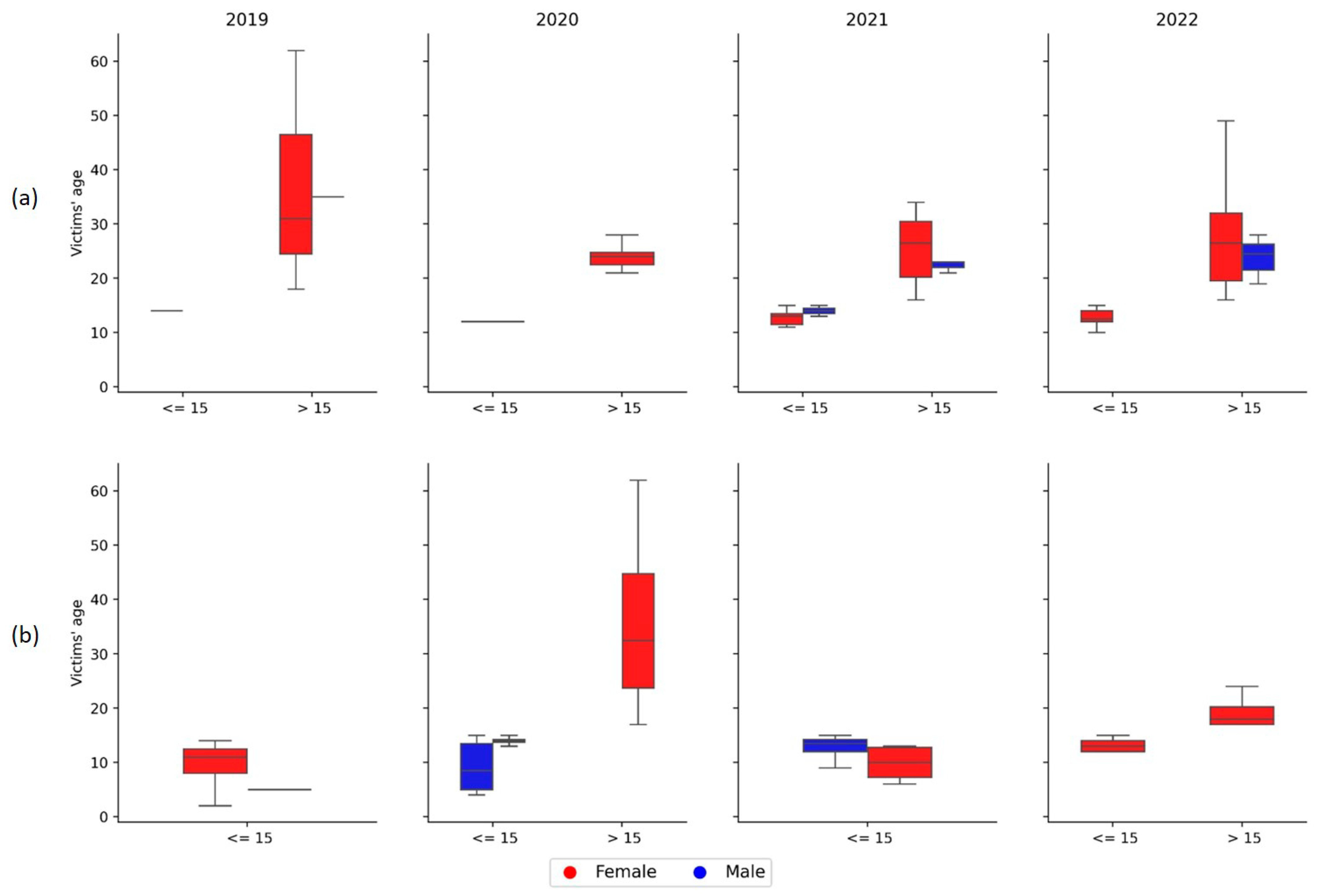Characterizing Spatio-Temporal Patterns of Child Sexual Abuse in Mexico City Before, During, and After the COVID-19 Pandemic
Abstract
:1. Introduction
2. Materials and Methods
2.1. Data Sources
2.1.1. Crime Data
2.1.2. Socioeconomic and Demographic Data
2.2. Study Design
3. Results
4. Discussion and Conclusions
Author Contributions
Funding
Data Availability Statement
Conflicts of Interest
References
- Haug, N.; Geyrhofer, L.; Londei, A.; Dervic, E.; Desvars-Larrive, A.; Loreto, V.; Pinior, B.; Thurner, S.; Klimek, P. Ranking the effectiveness of worldwide COVID-19 government interventions. Nat. Hum. Behav. 2020, 4, 1303–1312. [Google Scholar] [CrossRef] [PubMed]
- Caron, F.; Plancq, M.-C.; Tourneux, P.; Gouron, R.; Klein, C. Was child abuse underdetected during the COVID-19 lockdown? Arch. Pediatr. 2020, 27, 399–400. [Google Scholar] [CrossRef] [PubMed]
- Rapp, A.; Fall, G.; Radomsky, A.C.; Santarossa, S. Child maltreatment during the COVID-19 pandemic: A systematic rapid review. Clin. N. Am. 2021, 68, 991–1009. [Google Scholar] [CrossRef] [PubMed]
- Felson, M.; Jiang, S.; Xu, Y. Routine activity effects of the Covid-19 pandemic on burglary in Detroit, March, 2020. Crime Sci. 2020, 9, 10. [Google Scholar] [CrossRef] [PubMed]
- Greenfeld, L. Child Victimizers: Violent Offenders and Their Victims; Bureau of Justice Statistics: Washington, DC, USA, 1996.
- Biderman, A.D.; Hindelang, M.J.; Gottfredson, M.R.; Garofalo, J. Victims of Personal Crime: An Empirical Foundation for a Theory of Personal Victimization; Ballinger: Cambridge, MA, USA, 1978. [Google Scholar]
- Cohen, L.E.; Felson, M. Social change and crime rate trends: A routine activity approach. Am. Sociol. Rev. 1979, 44, 588. [Google Scholar] [CrossRef]
- Cohen, L.E.; Kluegel, J.R.; Land, K.C. Social inequality and predatory criminal victimization: An exposition and test of a formal theory. Am. Sociol. Rev. 1981, 46, 505–524. [Google Scholar] [CrossRef]
- McNeeley, S. Lifestyle-routine activities and crime events. J. Contemp. Crim. Justice 2015, 31, 30–52. [Google Scholar] [CrossRef]
- Rosenthal, C.M.; Thompson, L.A. Child abuse awareness month during the coronavirus disease 2019 pandemic. JAMA Pediatr. 2020, 174, 812. [Google Scholar] [CrossRef]
- Seddighi, H.; Salmani, I.; Javadi, M.H.; Seddighi, S. Child abuse in natural disasters and conflicts: A systematic review. Trauma Violence Abus. 2021, 22, 176–185. [Google Scholar] [CrossRef]
- Bérubé, A.; Clément, M.; Lafantaisie, V.; LeBlanc, A.; Baron, M.; Picher, G.; Turgeon, J.; Ruiz-Casares, M.; Lacharité, C. How societal responses to COVID-19 could contribute to child neglect. Child Abus. Negl. 2021, 116, 104761. [Google Scholar] [CrossRef]
- Campbell, A.M. An increasing risk of family violence during the Covid-19 pandemic: Strengthening community collaborations to save lives. Forensic Sci. Int. Rep. 2020, 2, 100089. [Google Scholar] [CrossRef] [PubMed]
- Lee, S.J.; Ward, K.P.; Lee, J.Y.; Rodriguez, C.M. Parental social isolation and child maltreatment risk during the COVID-19 pandemic. J. Fam. Violence 2021, 37, 813–824. [Google Scholar] [CrossRef] [PubMed]
- Salt, E.; Wiggins, A.T.; Cooper, G.L.; Benner, K.; Adkins, B.W.; Hazelbaker, K.; Rayens, M.K. A comparison of child abuse and neglect encounters before and after school closings due to SARS-Cov-2. Child Abus. Negl. 2021, 118, 105132. [Google Scholar] [CrossRef] [PubMed]
- Amick, M.; Bentivegna, K.; Hunter, A.A.; Leventhal, J.M.; Livingston, N.; Bechtel, K.; Holland, M.L. Child maltreatment-related children’s emergency department visits before and during the COVID-19 pandemic in Connecticut. Child Abus. Negl. 2022, 128, 105619. [Google Scholar] [CrossRef] [PubMed]
- Raman, S.; Harries, M.; Nathawad, R.; Kyeremateng, R.; Seth, R.; Lonne, B. Where do we go from here? A child rights-based response to COVID-19. BMJ Paediatr. Open 2020, 4, e000714. [Google Scholar] [CrossRef] [PubMed]
- Usher, K.; Bhullar, N.; Durkin, J.; Gyamfi, N.; Jackson, D. Family violence and COVID-19: Increased vulnerability and reduced options for support. Int. J. Ment. Health Nurs. 2020, 29, 549–552. [Google Scholar] [CrossRef] [PubMed]
- Loiseau, M.; Cottenet, J.; Bechraoui-Quantin, S.; Gilard-Pioc, S.; Mikaeloff, Y.; Jollant, F.; François-Purssell, I.; Jud, A.; Quantin, C. Physical abuse of young children during the COVID-19 pandemic: Alarming increase in the relative frequency of hospitalizations during the lockdown period. Child Abus. Negl. 2021, 122, 105299. [Google Scholar] [CrossRef] [PubMed]
- Piquero, A.R.; Kurland, J. More stringent measures against COVID-19 are associated with less cases and deaths in Florida and Miami-Dade. Am. J. Emerg. Med. 2021, 53, 262–263. [Google Scholar] [CrossRef] [PubMed]
- Brantingham, P.J.; Brantingham, P.L. Environmental Criminology; Sage Publications: Beverly Hills, CA, USA, 1981. [Google Scholar]
- Vilalta, C.; Fondevila, G.; Massa, R. The impact of anti-COVID-19 measures on Mexico City criminal reports. Deviant Behav. 2022, 44, 723–737. [Google Scholar] [CrossRef]
- Brantingham, P.; Brantingham, P. Crime pattern theory. Environ. Criminol. Crime Anal. 2013, 100–116. [Google Scholar] [CrossRef]
- Braga, A.A.; Schnell, C. Evaluating police-based policing strategies: Lessons learned from the smart policing Initiative in Boston. Police Q. 2013, 16, 339–357. [Google Scholar] [CrossRef]
- Sampson, R.J.; Groves, W.B. Community structure and crime: Testing social-disorganization theory. Am. J. Sociol. 1989, 94, 774–802. [Google Scholar] [CrossRef]
- Coulton, C.J.; Crampton, D.S.; Irwin, M.; Spilsbury, J.C.; Korbin, J.E. How neighborhoods influence child maltreatment: A review of the literature and alternative pathways. Child Abus. Negl. 2007, 31, 1117–1142. [Google Scholar] [CrossRef] [PubMed]
- Tavares, J.P.; Costa, A.C. Spatial Modeling and Analysis of the Determinants of Property Crime in Portugal. ISPRS Int. J. Geo-Information 2021, 10, 731. [Google Scholar] [CrossRef]
- Sun, Y.; Huang, Y.; Yuan, K.; Chan, T.O.; Wang, Y. Spatial Patterns of COVID-19 Incidence in Relation to Crime Rate Across London. ISPRS Int. J. Geo-Information 2021, 10, 53. [Google Scholar] [CrossRef]
- Yang, M.; Chen, Z.; Zhou, M.; Liang, X.; Bai, Z. The Impact of COVID-19 on Crime: A Spatial Temporal Analysis in Chicago. ISPRS Int. J. Geo-Information 2021, 10, 152. [Google Scholar] [CrossRef]
- Brantingham, P.J.; Tita, G.E.; Mohler, G. Gang-related crime in Los Angeles remained stable following COVID-19 social distancing orders. Criminol. Public Policy 2021, 20, 423–436. [Google Scholar] [CrossRef]
- Leśniak, A.; Polończyk, A.; Waśniowski, P. Variations in the spatial distribution of crime events in an urban environment during the COVID-19 lockdown. Cartogr. Geogr. Inf. Sci. 2022, 49, 171–188. [Google Scholar] [CrossRef]
- Moise, I.K.; Piquero, A.R. Geographic disparities in violent crime during the COVID-19 lockdown in Miami-Dade County, Florida, 2018–2020. J. Exp. Criminol. 2023, 19, 97–106. [Google Scholar] [CrossRef]
- Barboza, G.E.; Schiamberg, L.B.; Pachl, L. A spatiotemporal analysis of the impact of COVID-19 on child abuse and neglect in the city of Los Angeles, California. Child Abus. Negl. 2021, 116, 104740. [Google Scholar] [CrossRef]
- Estévez-Soto, P.R. Crime and COVID-19: Effect of changes in routine activities in Mexico City. Crime Sci. 2021, 10, 15. [Google Scholar] [CrossRef] [PubMed]
- Andresen, M.A.; Hodgkinson, T. In a world called catastrophe: The impact of COVID-19 on neighbourhood level crime in Vancouver, Canada. J. Exp. Criminol. 2022, 19, 487–511. [Google Scholar] [CrossRef] [PubMed]
- Lersch, K.M. An exploratory spatiotemporal analysis of domestic disturbance calls for service in 2020: The case of Tampa, Florida, USA. Int. J. Comp. Appl. Crim. Justice 2022, 1–16. [Google Scholar] [CrossRef]
- Lersch, K.M.; Hart, T.C. Does routine activity theory still matter during COVID-19 restrictions? The geography of sexual assaults before, during, and after COVID-19 restrictions. J. Crim. Justice 2023, 86, 102050. [Google Scholar] [CrossRef] [PubMed]
- Poonam, K.S.; Rushi, K.B. An Application of Scan Statistics in Identification and Analysis of Hotspot of Crime against Women in Rajasthan, India. Appl. Spat. Anal. 2024. [Google Scholar] [CrossRef]
- Jiang, X.; Mao, Z.; Zheng, Z.; Lin, Z.; Wang, Y.; Sheng, S. Spatio-temporal characteristics of sexual crime and influencing factors of commercial service facilities: A case study of Haining City, China. Int. J. Law Crime Justice 2024, 76, 100647. [Google Scholar] [CrossRef]
- CONEVAL. La Pobreza Urbana en México: Un Enfoque Geoespacial. 2019. Available online: https://www.coneval.org.mx/Medicion/Documents/Pobreza_urbana/Documentos_metodologicos/Nota_tecnica.pdf (accessed on 21 June 2024).
- West, M. Time series decomposition. Biometrika 1997, 84, 489–494. [Google Scholar] [CrossRef]
- Getis, A. Spatial Autocorrelation. In Handbook of Applied Spatial Analysis; Fischer, M., Getis, A., Eds.; Springer: Berlin/Heidelberg, Germany, 2010; pp. 255–278. [Google Scholar] [CrossRef]
- Anselin, L. Local indicators of spatial association—LISA. Geogr. Anal. 1995, 27, 93–115. [Google Scholar] [CrossRef]
- Dubin, R. Spatial Weights. In The SAGE Handbook of Spatial Analysis; Fotheringham, A.S., Rogerson, P.A., Eds.; Sage: London, UK, 2009; pp. 125–158. [Google Scholar]
- Lee, S.I. Developing a bivariate spatial association measure: An integration of Pearson’s r and Moran’s I. J. Geogr. Syst. 2001, 3, 369–385. [Google Scholar] [CrossRef]
- Prettyman, A. Underreporting child maltreatment during the pandemic: Evidence from Colorado. Child. Youth Serv. Rev. 2024, 156, 107342. [Google Scholar] [CrossRef]
- Marmor, A.; Cohen, N.; Katz, C. Child maltreatment during COVID-19: Key conclusions and future directions based on a systematic literature review. Trauma Violence Abus. 2023, 24, 760–775. [Google Scholar] [CrossRef] [PubMed]
- Baron, E.J.; Goldstein, E.G.; Wallace, C.T. Suffering in silence: How COVID-19 school closures inhibit the reporting of child maltreatment. J. Public Econ. 2020, 190, 104258. [Google Scholar] [CrossRef] [PubMed]
- Hayden, T.B. Criminalization through complicity: (Not) reporting crime in Mexico City. PoLAR Politi Leg. Anthr. Rev. 2020, 43, 211–227. [Google Scholar] [CrossRef]
- Nelson, E.L.; Saade, D.R.; Greenough, P.G. Gender-based vulnerability: Combining Pareto ranking and spatial statistics to model gender-based vulnerability in Rohingya refugee settlements in Bangladesh. Int. J. Health Geogr. 2020, 19, 20. [Google Scholar] [CrossRef]
- Pinciotti, C.M.; Seligowski, A.V. The influence of sexual assault resistance on reporting tendencies and law enforcement response: Findings from the National Crime Victimization Survey. J. Interpers. Violence 2021, 36, NP11176–NP11197. [Google Scholar] [CrossRef]




| Child Sexual Abuse | Moran’s Index | p-Value | Z-Score |
|---|---|---|---|
| All victims | 0.1535 | 0.001 | 12.7086 |
| Victims < 15 years old | 0.1476 | 0.001 | 11.9604 |
| Victims > 15 years old | 0.1501 | 0.001 | 12.6934 |
| Victims < 15 Years Old | Victims > 15 Years Old | ||||||
|---|---|---|---|---|---|---|---|
| Poverty | Population | Schooling Years | Poverty | Population | Schooling Years | ||
| 2019 | Moran’s I | −0.069 | 0.084 | −0.36 | 0.079 | −0.017 | 0.05 |
| p-values | 0.383 | 0.303 | 0.01 | 0.364 | 0.49 | 0.311 | |
| Z-score | 0.5385 | 0.636 | −2.42 | 1.07 | −0.13 | 0.109 | |
| 2020 | Moran’s I | 0.067 | 0.18 | −0.041 | 0.200 | 0.12 | 0.072 |
| p-values | 0.299 | 0.11 | 0.363 | 0.05 | 0.144 | 0.236 | |
| Z-score | 0.470 | 1.20 | −0.33 | 1.48 | 1.09 | 0.50 | |
| 2021 | Moran’s I | 0.28 | −0.173 | 0.29 | 0.178 | −0.23 | 0.310 |
| p-values | 0.05 | 0.079 | 0.008 | 0.172 | 0.071 | 0.08 | |
| Z-score | 1.99 | −1.40 | 2.20 | 1.009 | −1.42 | 1.54 | |
| 2022 | Moran’s I | −0.118 | 0.04 | −0.22 | 0.039 | −0.177 | 0.006 |
| p-values | 0.182 | 0.324 | 0.027 | 0.396 | 0.054 | 0.482 | |
| Z-score | −0.94 | 0.370 | −1.54 | 0.317 | −1.70 | 0.0144 | |
| Cluster | Age Group | Cluster | Years | p-Value | # Victims | Schooling Years | Poverty |
|---|---|---|---|---|---|---|---|
| 1 | <15 years | Hotspot | 21/22 | 0.02/0.036 | 2/2 | 10.14 | 18–34 |
| 2 | 21/22 | 0.001/0.044 | 2/2 | 11.22 | 18–34 | ||
| 1 | Diamond | 20/22 | 0.001/0.001 | 2/2 | 10.35 | 34–50 | |
| 1 | >15 years | Hotspot | 20/22 | 0.034/0.001 | 2/5 | 10.07 | 18–34 |
| 2 | 21/22 | 0.016/0.003 | 3/4 | 13.31 | 0–18 | ||
| 3 | 21/22 | 0.01/0.001 | 2/3 | 11.81 | 0–18 | ||
| 4 | 21/22 | 0.002/0.021 | 2/2 | 11.86 | 0–18 | ||
| 1 | Diamond | 20/22 | 0.001/0.001 | 2/2 | 10.51 | 0–18 |
Disclaimer/Publisher’s Note: The statements, opinions and data contained in all publications are solely those of the individual author(s) and contributor(s) and not of MDPI and/or the editor(s). MDPI and/or the editor(s) disclaim responsibility for any injury to people or property resulting from any ideas, methods, instructions or products referred to in the content. |
© 2024 by the authors. Licensee MDPI, Basel, Switzerland. This article is an open access article distributed under the terms and conditions of the Creative Commons Attribution (CC BY) license (https://creativecommons.org/licenses/by/4.0/).
Share and Cite
Carrillo-Brenes, F.; Vilches-Blázquez, L.M. Characterizing Spatio-Temporal Patterns of Child Sexual Abuse in Mexico City Before, During, and After the COVID-19 Pandemic. ISPRS Int. J. Geo-Inf. 2024, 13, 223. https://doi.org/10.3390/ijgi13070223
Carrillo-Brenes F, Vilches-Blázquez LM. Characterizing Spatio-Temporal Patterns of Child Sexual Abuse in Mexico City Before, During, and After the COVID-19 Pandemic. ISPRS International Journal of Geo-Information. 2024; 13(7):223. https://doi.org/10.3390/ijgi13070223
Chicago/Turabian StyleCarrillo-Brenes, Francisco, and Luis M. Vilches-Blázquez. 2024. "Characterizing Spatio-Temporal Patterns of Child Sexual Abuse in Mexico City Before, During, and After the COVID-19 Pandemic" ISPRS International Journal of Geo-Information 13, no. 7: 223. https://doi.org/10.3390/ijgi13070223






